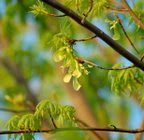NPR had a run a story this afternoon called Leaves Keep Their Cool from the Naturenews magazine. (Interesting choice of leaf on the website. It looks like poison Oak.) Have you ever noticed where snow melts first? Around the trunk of a tree and out from its roots. Trees are living breathing things that create some amount of heat through respiration. How can a Landscape Architect capitalize on this? We all ready do. We suggest trees to moderate street temperatures, cool patios, break wind and create micro-climates for sensitive plants.
I usually grab lunch at a close fast-food place (my waste line is starting to show it, so I am working on changing that habit.) and park at a municipal park just up the road to eat my lunch and take a nap. They are repairing the parking lot, so my favorite shady spot has been taken over by gravel and earth piles. I don't expect any tree islands to go into the new parking lot, which is a shame (I've seen the plans--no new trees). There was four shady spots in the parking lot, and I got the last one. The parking lot probably holds over a hundred cars, but only shade for 4 cars. None of us were parked in designated parking spots; we were parked in the shade. The shade of just one tree allowed me to shut off my engine, roll the windows down and eat my lunch comfortably. That tree, for the 45 minutes I was sitting under it, was doing double duty. It was absorbing carbon from the air through respiration, and it allowed me to stop expelling carbon through my muffler. Shaded parking should be mandatory and written into municipal code. There are a hundred other reasons why trees should be planted in addition to my selfish comfort.
Report: Most Oklahoma Bodies of Water are Polluted
I read this article or heard it on the news somewhere, but was reminded by my "waterhugging" friend to reread it. (thanks Kristina for caring about the our world). In 2002, 76% of Oklahoma's water was impaired and only 74 % of its water assessed was good was the report given to congress by the EPA. This problem just didn't happen yesterday. Unless you consider 1898 yesterday. This should be a wake up call for Oklahoma. I'm not surprised at all by this finding. Oklahoma does not adequately protect it water resource. How can this be acceptable? It was just a few weeks ago I had a professional in the utility industry tell me what a waste of time silt fences are. Sometimes I find Oklahoma so backward when it comes to environmental practices. I worked in the building industry when I first came to Oklahoma, just 7 years ago, and had homeowners tell me just pour my paint waste down into the street drain. Is it time for a Water Conservation Service to step in and do for Oklahoma what the Soil Conservation Service did during and after the dustbowl?Twin Creek and Brock Creek run through Rotary Park. I suspect that Twin Creek was straightened when the railroad was put in the early 1900s, maybe before 1900. The creek runs straight as an arrow along the tracks from Rotary Park until it dumps into the North Canadian River (The Oklahoma River). Rotary Park was accepted by the city from the Rotary Club in 1924. Brock Creek runs through the center of Brock Park and is "armored" (lined with concrete). Brock Park was added to the city park system very early in the 1900s. The pictures below are of Twin Creek running through Rotary Park, and Brock Park connecting with Twin Creek. These two streams have been under the stewardship of Oklahoma City since at least 1924 (For 84 years). I would say they are typical of creeks throughout Oklahoma City and other central Oklahoma cities. I don't find the stewardship of this stream something to be proud of.
 Twin Creek has been straightened, which rapidly erodes the banks. Used concrete and asphalt containing years of vehicle pollutants are used to stabilize the banks. Their is no variation of depth, because of lack of sinuosity, which allows for pool and riffle formation. Sinuosity, pools and riffles reduce water energy, sediment transport and slows erosion. Variation of stream characteristics provide vital habitat for stream creatures.
Twin Creek has been straightened, which rapidly erodes the banks. Used concrete and asphalt containing years of vehicle pollutants are used to stabilize the banks. Their is no variation of depth, because of lack of sinuosity, which allows for pool and riffle formation. Sinuosity, pools and riffles reduce water energy, sediment transport and slows erosion. Variation of stream characteristics provide vital habitat for stream creatures. A winter picture of Brock Creek on the left connecting with Twin Creek flowing under the road. The water from Brock Creek is "armored" and "hungry" when it gets to Twin Creek. There is no sediment in it, no texture or roughness to the ground, no sinuosity, no pools and riffles. So it has maximum energy on arrival and will require constant earth work to maintain its current configuration. Think what happens when you lay a open hose on the ground. It will immediately dig a hole in the ground, then as the stream of water gets further from the hose it loses energy and starts meandering. Any vegetation will greatly reduce erosion, stabilize the ground, and the roots provide openings for the water to be absorbed quickly into the ground.
A winter picture of Brock Creek on the left connecting with Twin Creek flowing under the road. The water from Brock Creek is "armored" and "hungry" when it gets to Twin Creek. There is no sediment in it, no texture or roughness to the ground, no sinuosity, no pools and riffles. So it has maximum energy on arrival and will require constant earth work to maintain its current configuration. Think what happens when you lay a open hose on the ground. It will immediately dig a hole in the ground, then as the stream of water gets further from the hose it loses energy and starts meandering. Any vegetation will greatly reduce erosion, stabilize the ground, and the roots provide openings for the water to be absorbed quickly into the ground. Lack of tree cover to shade the water; fertilizers washing into the stream; and lack of plant life absorbing nutrients causes this early spring algae growth. Trees and plants protect the water with shade, moderating the temperature. Vegetation also absorbs water and nutrients, stabilize banks and provide habitat for land and aquatic creatures. This creek has been tranquilized for 84 years and is dying or dead. Our hydrological system is the central nerve system of the ecology. We may think we are tranquilizing the stream, but really we are warehousing poisons and pollutions that the environment normally neutralize.
Lack of tree cover to shade the water; fertilizers washing into the stream; and lack of plant life absorbing nutrients causes this early spring algae growth. Trees and plants protect the water with shade, moderating the temperature. Vegetation also absorbs water and nutrients, stabilize banks and provide habitat for land and aquatic creatures. This creek has been tranquilized for 84 years and is dying or dead. Our hydrological system is the central nerve system of the ecology. We may think we are tranquilizing the stream, but really we are warehousing poisons and pollutions that the environment normally neutralize. I went to visit the stream with my kids. Streams are for kids. It is one of the most important places we can teach them about how nature works. There are more cycles and processes occurring at the waters edge than anywhere else. I'm not sure that is a true statement, but I believe it to be true. Kids should be turning over rocks, skipping stones, and finding frogs, salamanders and turtles. It was kind of cool when we stepped over the bank of Twin Creek and looked down. There was a Heron (not a type I had seen before) and a pair of ducks I was unfamiliar with. I didn't have my long lense on my camera, so I was unable to get a readable picture of them. There must be some life still left in the stream. It was kind of sad watching them though. It was like watching songbirds bathing in that last little pool of water in the parking lot days after the last rain. It is that little intermittent pool with the oily sheen which collects and stores oils and pollutants off of vehicles.
I went to visit the stream with my kids. Streams are for kids. It is one of the most important places we can teach them about how nature works. There are more cycles and processes occurring at the waters edge than anywhere else. I'm not sure that is a true statement, but I believe it to be true. Kids should be turning over rocks, skipping stones, and finding frogs, salamanders and turtles. It was kind of cool when we stepped over the bank of Twin Creek and looked down. There was a Heron (not a type I had seen before) and a pair of ducks I was unfamiliar with. I didn't have my long lense on my camera, so I was unable to get a readable picture of them. There must be some life still left in the stream. It was kind of sad watching them though. It was like watching songbirds bathing in that last little pool of water in the parking lot days after the last rain. It is that little intermittent pool with the oily sheen which collects and stores oils and pollutants off of vehicles. What is really sad is that this photo is not unusual for streams in the metro area. River and stream banks have been traditionally places to dump. They were lands that were inhabitable, so were suited for fill. What better fill than trash. According to the EPA, Oklahoma has lost 67% of its wetlands since circa 1780. Notice where OKC's landfills are. Norman dumped into the river for years south of campus.
What is really sad is that this photo is not unusual for streams in the metro area. River and stream banks have been traditionally places to dump. They were lands that were inhabitable, so were suited for fill. What better fill than trash. According to the EPA, Oklahoma has lost 67% of its wetlands since circa 1780. Notice where OKC's landfills are. Norman dumped into the river for years south of campus.
More people should care more about our hydrologic system in the metro. This little blurb in the news about polluted water is just the visible tip of the iceberg. The metro faces a complex problem that cosmetic solutions will not fix. It will take a serious commitment, which I have not seen in the metro. The new wetland downtown is just eye-candy and soul-balm and a cosmetic fix for a terminal problem.

